
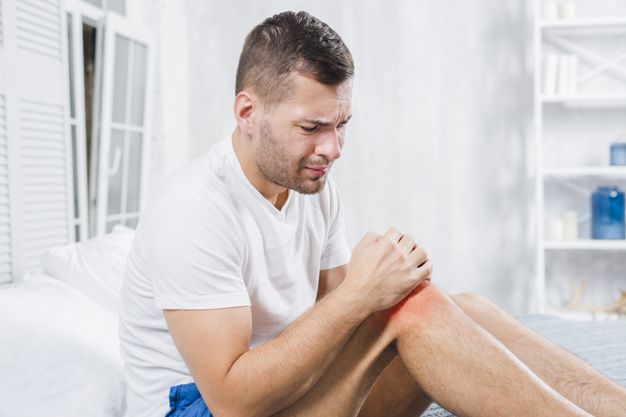
There’s no doubt knee braces are important when nursing an injury or for injury prevention, but choosing the right one can be a daunting task. Knowing more about how to pick the best knee brace for your individualized needs by using a knee support guide can make the process more enjoyable.
When to Wear a Knee Brace
In general, braces should be worn if you’re having knee pain or you wish to prevent injuries during high contact sports where there is a higher likelihood of knee injury. Knee braces can also be used for rehabilitative purposes, for example, following an ACL injury. The brace will provide slow, limited movement allowing the patient to gradually regain their range of motion. Knee braces also come in handy for arthritis sufferers as it can aid in reducing pain and inflammation. Your doctor can help you decide if it’s necessary.
Levels of Protection
When choosing a knee brace, look for levels of protection ranging from 1 to 3+.
A Level 1 Brace offers the least amount of support, but is the most flexible, such as a knee sleeve. It’s best for pain relief and mild to moderate support when remaining fully active.
Level 2 Braces offer more protection than Level 1, they aren’t as flexible, but still allow for a range of movement. Wraparound braces and knee straps are good examples. You’ll receive mild to moderate knee support for pain relief associated with ligament instabilities and tendonitis.
A Level 3 Brace, such as a hinged knee brace, offers you the most support but limited movement. This type of brace is also generally heavier. It’s best for recovering from surgery, when knee movement should be limited to prevent re-injuring yourself. To take it a step further, there is always the option of a 3+ Level for Maximum Protection. This level is best for aiding in pain relief and support for moderate to major instabilities and conditions
Types of Knee Braces
There are several types of knee braces available to choose from, such as sleeves, wraparound braces, hinged braces, and straps.
Knee Sleeves come in different sizes, and you can slip them right over your knee. They provide knee compression, which helps control swelling and pain. Knee Sleeves often work well for mild knee pain, and they help minimize arthritis. Sleeves are comfortable and can fit under clothing.
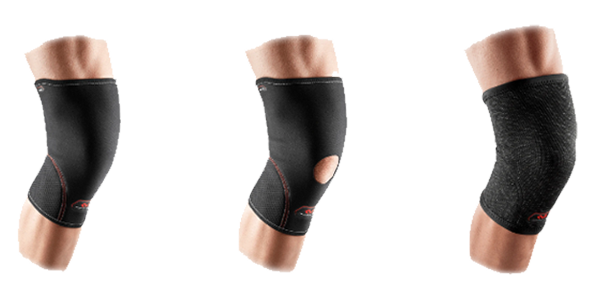
Wraparound or Dual-Wrap Braces work well for athletes experiencing mild to moderate knee pain, providing more support than sleeves. These braces are easy to put on and take off, and can be used while training – they don’t have the bulk and heaviness of hinged braces.
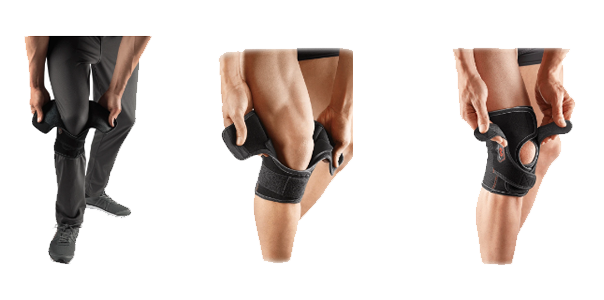
Hinged Knee Braces are often used post-surgery, for patients and athletes who need a higher level of protection and support. This type of brace keeps your knee in the proper alignment when it bends, to help heal and avoid further injuries. Your doctor may recommend a hinged knee brace after surgery, but another type of brace when you’ve reached a certain point in the healing process. Hinged braces are either rigid or soft, with soft ones providing less support than rigid braces.
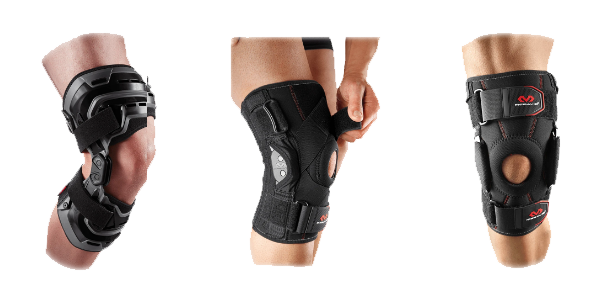
A Knee Strap is a great solution if you suffer from Knee Pain due to Runner’s knee or jumper’s knee (Patellar Tendonitis), Osgood-Schlatter Disease, or Patella Tracking. It can fit under clothes and is easy to put on and take off. Wearing this type of strap helps prevent patella injuries and minimizes knee pain by putting compression on your Patellar Tendon.
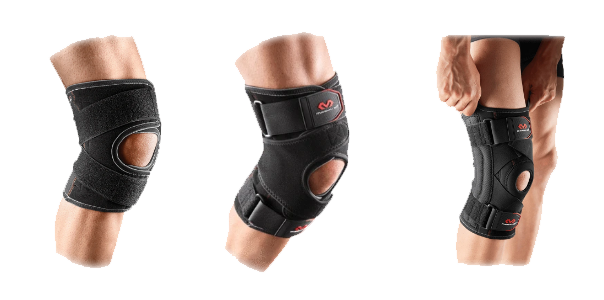
Closed and Open Patella Braces might be confusing when you see some braces with an open patella (a hole in the center of the brace) and others with a closed patella (no holes). Braces with an open patella allow relief of knee pressure and extra knee cap support with proper movement and tracking. Closed patella braces, on the other hand, offer compression at the knee cap with the same pressure as the rest of the knee and additional support. Ask your doctor if you are unsure which is a better option for your needs.
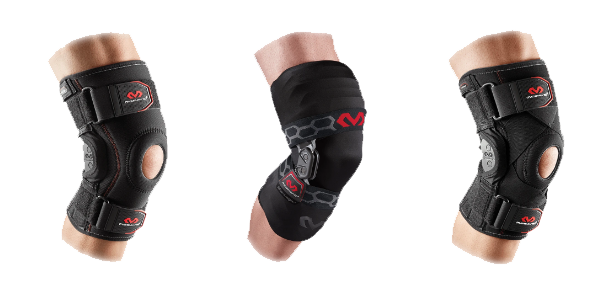
How to Measure For a Knee Brace?
We all need a little help sometimes when it comes to keeping our bodies in the right shape, especially when it comes to our knees. Whether you’ve got an old sports injury that you want to keep from acting up or if you’re recovering from recent surgery, one of the best ways to protect your knee is with a knee brace. But how do you measure for a knee brace to make sure you’ve got the right fit?
If you’re wondering about the entire process of measuring for a knee brace, don’t worry; you’ve come to the right place. In fact, we’ve got the definitive knee brace sizing guide below. Here, you’ll learn all the basics: what simple tools you need to measure the dimensions of your knee and leg, where and how to measure those dimensions, and then how to take those measurements and translate them into choosing the right brace for you. Let’s get started!
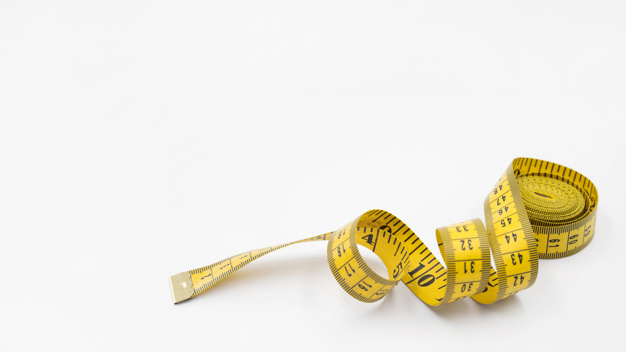
You need to ensure you get the most accurate measurements of your body as possible in order to get the best-fitting knee brace, as this will keep your knee safe and protected while you work, play, or heal. But because our bodies have all sorts of curves, you can’t exactly use a ruler. Thankfully, a soft tape measure (sometimes called a tailor’s measuring tape) will do the job nicely.
If you don’t have a soft tape measure, though, you don’t have to run out and get one. There are some workarounds you can use. Anything that’s long enough to wrap around your leg, like a piece of rope, an extension cord, or even a phone charging cable, can be used, as long as you then measure it against a straight ruler or a traditional tape measure afterward. Just make sure you take as accurate a reading as possible!

Just having the right tools to measure the dimensions of your leg and knee won’t help unless you know which measurements to take. In this case, you’ll need some very specific dimensions to help you select an appropriately-sized brace. They include the circumference of your thigh and the circumference of your calf, both measured at about six inches from the center of your kneecap. As you measure, make sure that the soft measuring tape (or whatever you’re using to measure) is flush with your skin for an accurate reading. Also, as most knee brace manufacturers size in inches, make sure not to use centimeters while recording your calf and thigh circumference.
A few things you should also keep in mind during this measuring process: if you’re currently suffering from inflammation and swelling in your leg or knee joint, try to reduce that swelling first before measuring to increase your chances of getting an accurate measurement. Also, if it’s painful to bend your knee for this measuring process, you can also get a good straight-leg measurement from a standing position either with the help of a friend or a family member or while sitting down with your leg straight out in front of you with your heel resting on the floor.
Finally, as some knee braces take into account the width of your kneecap, measuring the circumference of your knee itself is a beneficial measurement you should consider taking as well. Be sure to measure from the very center of your kneecap, passing through the widest point, for the most accurate measurements. This can be accomplished either with a bent knee or a straight one, depending on your comfort level. Again, make sure your knee itself isn’t swollen or inflamed so you don’t end up with an oversized measurement.
Knee braces need to fit snugly in order to provide the optimal support for your knee joint, and that means you need to have a snug fit. This means that not only do you need to take the most accurate measurements possible, but you also need to then take those measurements and use them to choose a knee brace of the appropriate size. Selecting one that’s too big won’t provide you the support you need, while choosing one that’s too small could be too restrictive and possibly cause even more injury or make your recovery time even longer.
Selecting the right size knee brace isn’t always as easy as selecting one that matches your exact measurements, though. Unlike shoes, for example, there’s no set standard that’s used for knee brace sizing. Instead, most companies make their braces available in size categories. Even these categories can differ, but they usually shake down into small, medium, large, and extra-large or something similar. Each of these categories is meant to accommodate a range of thigh and calf sizes in inches (and knee sizes, where applicable).
Again, each manufacturer will use a slightly different range. You may be a Medium according to one knee brace maker, but you might end up being sized as a Small or a Large by another manufacturer. It’s beneficial to keep in mind that your knee brace needs to be snug but not too tight, so it’s often recommended to choose the smaller size if you fall in between two of them unless the manufacturer says otherwise.
Finding a brace that fits your knee correctly is always your first priority when it comes to choosing knee braces. At the same time, there are more than a few other things to keep in mind when you’re selecting a knee brace, simply because there are so many different types of braces out there on the market that work in similar but sometimes significantly different ways. Understanding these differences is crucial for choosing a brace that will provide your knee joint the strength and flexibility it needs to function safely or heal properly.
You will need to make a decision regarding the type of knee brace you need. More simple braces, such as knee sleeves, offer minor protection but are usually the easiest to take on and off, for example, and they do provide good compression. More complex braces, such as those that wrap around your knee at the top and the bottom, often feature better protection and more support, but are certainly overkill if you just have a very minor injury or only require modest protection.
There are even more complex braces as well. These include knee straps for those suffering from runner’s knee, hinged knee braces for those that need serious support following an injury or surgery, or those that provide lifting assistance through the use of high-strength springs. Many of these braces will protect the kneecap from injury; others will leave it bare to provide a better range of movement. Choosing the one that’s best for you is often a combination of personal preference coupled with what your doctor or physical therapist recommends as most appropriate for your injury.
At first glance, it may seem that choosing a knee brace is as simple as clicking your mouse. In many ways that’s absolutely true — it’s now easier than ever to choose a brace over the internet and have it delivered right to your door. By the same token, though, you need to take care with what type of brace you’re ordering and whether you’ve selected one that’s going to match the dimensions of your leg to provide your knee the support it needs.
This is, of course, why you need to measure your leg for a knee brace as carefully and accurately as possible. You need to use the right tools for the job and to measure the right parts of your leg — your calf, your thigh, and even across the widest part of your knee itself — to get these measurements, and then you need to select a brace that matches those measurements as closely as possible. On top of that, you need to make sure the style and design of brace that you’re ordering will provide you the right level of protection you need without being overkill!
That’s why it’s important to consult with a professional if you have any doubts at all about the type of brace you should be using or how to choose the appropriate size. The best resource for you is always going to be a medical professional. If you’re working with an orthopedist or a sports medicine expert, or if you’re undergoing physical therapy to rehabilitate an injured knee in partnership with a qualified physical or occupational therapist, rely on their informed counsel to help you make your final decision.
Remember: whether you want to protect your knee from injury or provide it with the support it requires to heal after surgery, a knee brace of the right size and type is one of the best ways to do so. Choose appropriately and you’ll be in good shape!
If you need help finding the right product, still struggling to select the correct size, or have a question on your order, please call us anytime at (800) 409-3962 or use our contact form to send us an e-mail info@pediacaremed.com
Brands we work with:


















